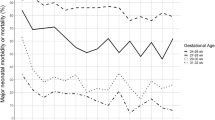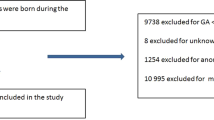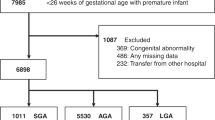Abstract
Objective:
Survival of preterm and very low birth weight (VLBW) infants has steadily improved. However, the rates of mortality and morbidity among the very smallest infants are poorly characterized.
Study Design:
Data from the California Perinatal Quality Care Collaborative for the years 2005 to 2012 were used to compare the mortality and morbidity of profoundly low birth weight (ProLBW, birth weight 300 to 500 g) and profoundly small for gestational age (ProSGA, <1st centile for weight-for-age) infants with very low birth weight (VLBW, birth weight 500 to 1500 g) and appropriate for gestational age (AGA, 5th to 95th centile for weight-for-age) infants, respectively.
Result:
Data were available for 44 561 neonates of birth weight <1500 g. Of these, 1824 were ProLBW and 648 were ProSGA. ProLBW and ProSGA differed in their antenatal risk factors from the comparison groups and were less likely to receive antenatal steroids or to be delivered by cesarean section. Only 14% of ProSGA and 21% of ProLBW infants survived to hospital discharge, compared with >80% of AGA and VLBW infants. The largest increase in mortality in ProSGA and ProLBW infants occurred prior to 12 h of age, and most mortality happened in this time period. Survival of the ProLBW and ProSGA infants was positively associated with higher gestational age, receipt of antenatal steroids, cesarean section delivery and singleton birth.
Conclusion:
Survival of ProLBW and ProSGA infants is uncommon, and survival without substantial morbidity is rare. Survival is positively associated with receipt of antenatal steroids and cesarean delivery.
This is a preview of subscription content, access via your institution
Access options
Subscribe to this journal
Receive 12 print issues and online access
$259.00 per year
only $21.58 per issue
Buy this article
- Purchase on Springer Link
- Instant access to full article PDF
Prices may be subject to local taxes which are calculated during checkout



Similar content being viewed by others
References
Melberg DM . Lay press material on preterm birth: no real progress in education on potentially problematic outcomes. Adv Neonatal Care 2014; 14 (2): 110–112.
Lucey JF, Rowan CA, Shiono P, Wilkinson AR, Kilpatrick S, Payne NR et al. Fetal infants: the fate of 4172 infants with birth weights of 401 to 500 grams—the Vermont Oxford Network experience (1996–2000). Pediatrics 2004; 113 (6): 1559–1566.
Akula VP, Gould JB, Davis AS, Hackel A, Oehlert J, Van Meurs KP . Therapeutic hypothermia during neonatal transport: data from the California Perinatal Quality Care Collaborative (CPQCC) and California Perinatal Transport System (CPeTS) for 2010. J Perinatol 2013; 33 (3): 194–197.
Finer NN, Powers RJ, Ou CH, Durand D, Wirtschafter D, Gould JB et al. Prospective evaluation of postnatal steroid administration: a 1-year experience from the California Perinatal Quality Care Collaborative. Pediatrics 2006; 117 (3): 704–713.
Wirtschafter DD, Danielsen BH, Main EK, Korst LM, Gregory KD, Wertz A et al. Promoting antenatal steroid use for fetal maturation: results from the California Perinatal Quality Care Collaborative. J Pediatr 2006; 148 (5): 606–612.
Lee HC, Green C, Hintz SR, Tyson JE, Parikh NA, Langer J et al. Prediction of death for extremely premature infants in a population-based cohort. Pediatrics 2010; 126 (3): e644–e650.
Fenton TR, Sauve RS . Using the LMS method to calculate z-scores for the Fenton preterm infant growth chart. Eur J Clin Nutr 2007; 61 (12): 1380–1385.
Fenton TR . A new growth chart for preterm babies: Babson and Benda's chart updated with recent data and a new format. BMC Pediatr 2003; 3: 13.
Griffin IJ . Mathematical description of postnatal growth: Z-scores an statistical control process analysis In: Griffin IJ (ed). Perinatal Growth and Nutrition. CRC Press: Roca Raton, FL, USA, 2014, pp 279–300.
Larroque B, Breart G, Kaminski M, Dehan M, Andre M, Burguet A et al. Survival of very preterm infants: Epipage, a population based cohort study. Arch Dis Child Fetal Neonatal Ed 2004; 89 (2): F139–F144.
Marlow N, Bennett C, Draper ES, Hennessy EM, Morgan AS, Costeloe KL . Perinatal outcomes for extremely preterm babies in relation to place of birth in England: the EPICure 2 study. Arch Dis Child Fetal Neonatal Ed 2014; 99 (3): F181–F188.
Mwansa-Kambafwile J, Cousens S, Hansen T, Lawn JE . Antenatal steroids in preterm labour for the prevention of neonatal deaths due to complications of preterm birth. Int J Epidemiol 2010; 39 (Suppl 1): i122–i133.
Roberts D, Dalziel S . Antenatal corticosteroids for accelerating fetal lung maturation for women at risk of preterm birth. Cochrane Database Syst Rev 2006; (3): CD004454.
Hoekstra RE, Ferrara TB, Couser RJ, Payne NR, Connett JE . Survival and long-term neurodevelopmental outcome of extremely premature infants born at 23-26 weeks' gestational age at a tertiary center. Pediatrics 2004; 113 (1 Pt 1): e1–e6.
Reddy UM, Zhang J, Sun L, Chen Z, Raju TN, Laughon SK . Neonatal mortality by attempted route of delivery in early preterm birth. Am J Obstet Gynecol 2012; 207 (2): 117 e111–117 e118.
Author information
Authors and Affiliations
Corresponding author
Ethics declarations
Competing interests
The authors declare no conflict of interest.
Rights and permissions
About this article
Cite this article
Griffin, I., Lee, H., Profit, J. et al. The smallest of the small: short-term outcomes of profoundly growth restricted and profoundly low birth weight preterm infants. J Perinatol 35, 503–510 (2015). https://doi.org/10.1038/jp.2014.233
Received:
Revised:
Accepted:
Published:
Issue Date:
DOI: https://doi.org/10.1038/jp.2014.233
This article is cited by
-
Maternal socioeconomic and lifestyle factors and life dissatisfaction associated with a small for gestational age infant. The Survey of Neonates in Pomerania (SNiP)
Archives of Gynecology and Obstetrics (2022)
-
Maternal dyslipidemia and altered cholesterol metabolism in early pregnancy as a risk factor for small for gestational age neonates
Scientific Reports (2021)
-
Population-based risks of mortality and preterm morbidity by gestational age and birth weight
Journal of Perinatology (2016)



